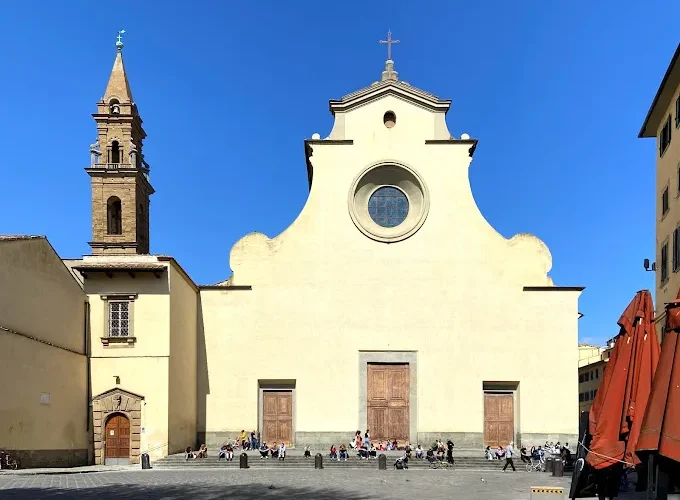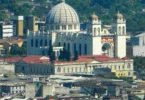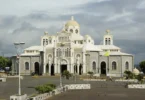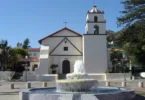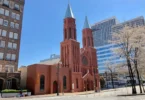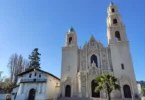Introduction
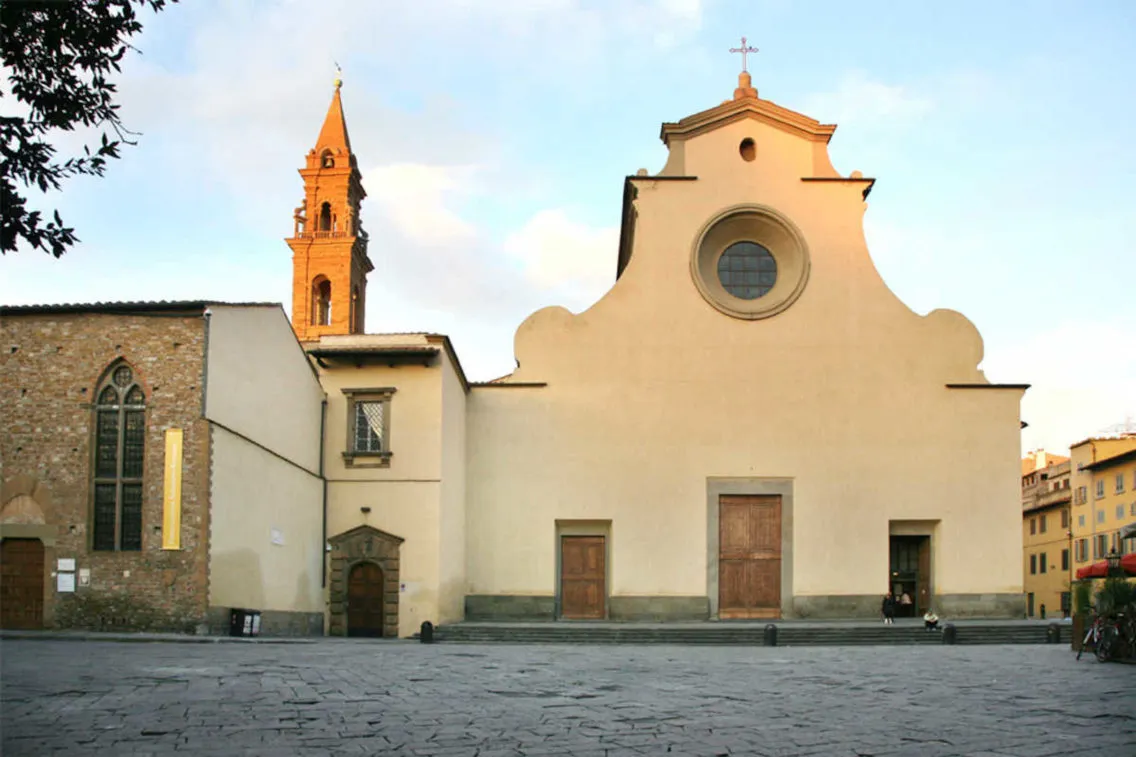
The Basilica di Santo Spirito, commonly known as Santo Spirito, is a prominent church located in the Oltrarno district of Florence, Italy. Positioned along the square that shares its name, this historic structure stands as a significant landmark in the area. Renowned for its stunning interior, the church extends to an impressive internal length of 97 meters (318 feet), making it one of the finest examples of Renaissance architecture. Its design showcases the harmonious proportions and elegant forms characteristic of the Renaissance style, reflecting the artistic and cultural flourishing of the period.
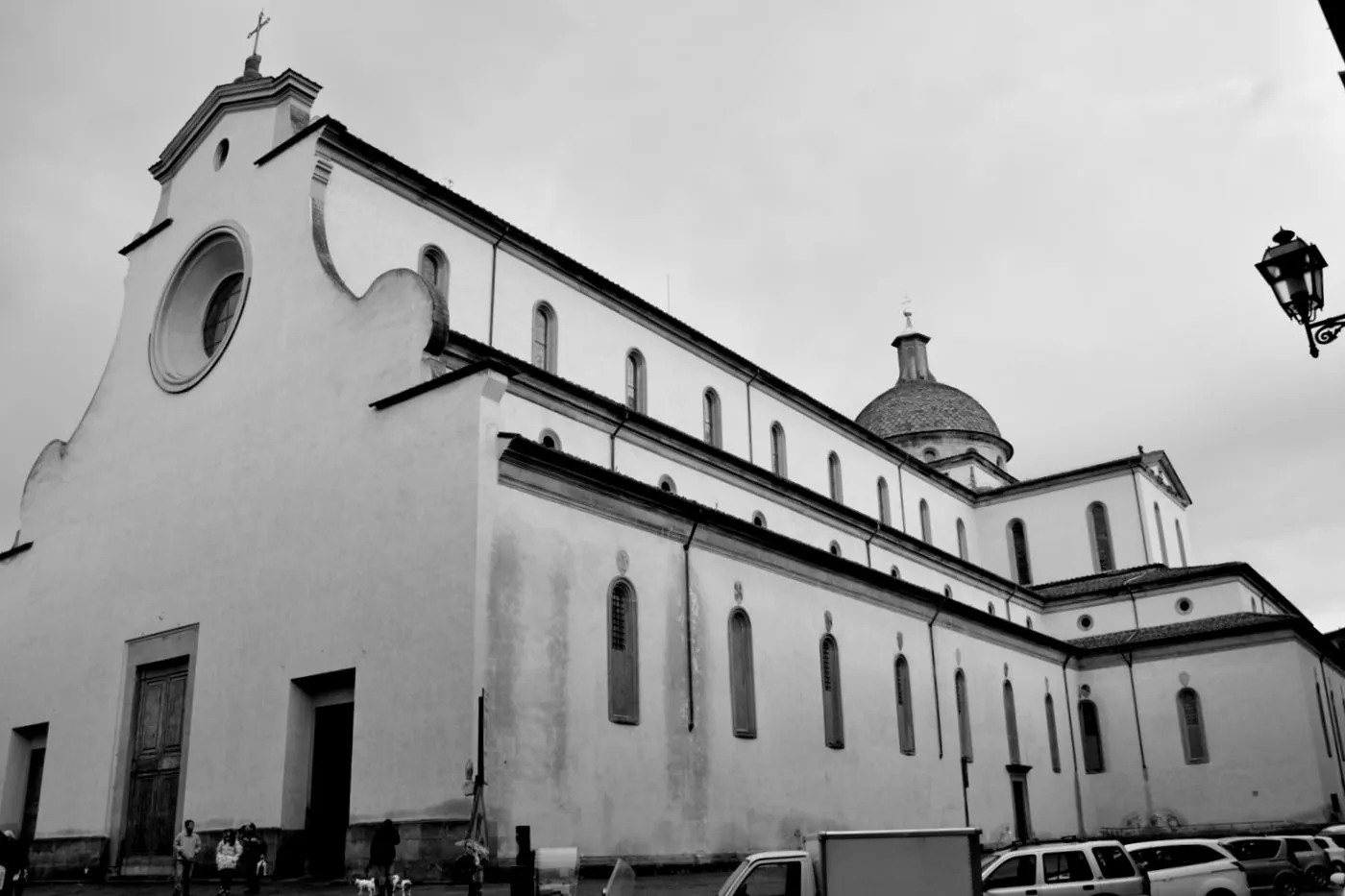
The Founding and Early Development of Santo Spirito
In 1250, Speziale and Acolti donated land on the south bank of the Arno River to Aldebrandino, a prior of the Augustinian establishment in Arcetri. This plot, located within the communal walls of 1173–1175 in the Oltrarno district, was sparsely populated at the time. Accessibility improved in 1252 with the construction of the Holy Trinity Bridge (Ponte Santa Trinita). That same year, the Augustinians began building their church and convent, incorporating the pre-existing church of San Romolo into the complex. Originally dedicated to Mary, All Saints, and the Holy Spirit, its dedication shifted by the end of the century to Mary, the Holy Spirit, and Matthew.
The financial support of the commune played a key role in the construction of mendicant churches like Santo Spirito. Funds were provided in 1267 and again from 1292 to 1301. By 1301, houses were purchased to create the Piazza Santo Spirito in front of the church. By 1310, the church featured seven altars and family chapels, which continued to expand over the next century. By the mid-14th century, the complex included a substantial cloister. Artistic contributions included frescoes of the Crucifixion and The Last Supper by Andrea Orcagna and his workshop in the 1360s.
Santo Spirito also became a center for scholarship and charity. Recognized as the Studium Generale of the Augustinian order in 1284, the convent hosted the approval of the order’s Rule and Constitutions in 1287. The laudese confraternity, founded before 1322 and dedicated to the Virgin Mary, staged annual Pentecost plays and supported charitable efforts, including a house for former prostitutes established by friar Simone Fidati da Cascia, which housed over fifty women by 1333.
Humanism, Political Turmoil, and the Rebuilding of Santo Spirito
Santo Spirito was closely linked to the rise of early humanism in Florence. In the 1360s and 1370s, Giovanni Boccaccio led a group of scholars at the convent and later bequeathed his library to it upon his death in 1375. In the 1380s and early 1390s, another circle of humanists, including Coluccio Salutati and Leonardo Bruni, met under the guidance of Luigi Marsili, a philosopher who had studied with Petrarch. These gatherings fostered intellectual exchanges that left a lasting impact on Florence’s cultural landscape.
During the politically unstable 1370s, Santo Spirito witnessed significant upheavals. The assassination of Sandro da Quarata, a prominent Ricci faction member, occurred outside the church in 1370. In 1378, during the Ciompi Revolt, the monastery was attacked but successfully defended by forces loyal to the signoria. Conspirators revealed plans for a major uprising centered around Santo Spirito, demonstrating its symbolic and strategic importance.
Following Florence’s victory over Milan in 1397 during the Second Milan War, the city resolved to rebuild Santo Spirito to honor Saint Augustine. However, substantial progress only began in 1434 when Filippo Brunelleschi was commissioned to design a new church. Construction advanced slowly, and in March 1471, during the sacra rappresentazione “Descent of the Holy Spirit” organized to celebrate Galeazzo Maria Sforza’s visit, the old church caught fire, causing significant damage to both the church and parts of the convent. This event accelerated the need for reconstruction, solidifying Santo Spirito’s enduring legacy in Florence.
Filippo Brunelleschi started planning the new church as soon as 1428, with huge primary components finished in 1446, only ten days before his demise. After his passing, the undertaking was gone on by his devotees, including Antonio Manetti, Giovanni da Gaiole, and Salvi d’Andrea, the last option likewise directing the development of the arch. In contrast to the Congregation of San Lorenzo, where Brunelleschi’s thoughts were obliged, Santo Spirito stuck all the more dependably to his vision, especially in the ground plan and up to the level of the arcades. The congregation includes a Latin cross format intended to upgrade primary lucidity. Not at all like San Lorenzo, the nave and transept were flawlessly coordinated, while uniform churches — forty altogether — were organized along the border.
Brunelleschi’s planned façade was rarely finished and stayed uncovered. In 1489, a segmented vestibule and octagonal sacristy were added to the congregation’s right side, planned by Simone del Pollaiolo (known as Il Cronaca) and Giuliano da Sangallo, separately. An entryway was opened in one of the houses of prayer to interface these augmentations to the congregation.
In 1601, a lavish baldachin with polychrome marbles was introduced over the high special stepped area by Giovanni Battista Caccini and Gherardo Silvani. The congregation stayed undecorated until the eighteenth century when the walls were put. Salvi d’Andrea planned the inside façade, which actually includes Pietro Perugino’s unique stained glass window portraying Pentecost. The ringer tower, finished in 1503, was planned by Baccio d’Agnolo. The structure’s outside went through rebuilding in 1977-78, safeguarding its verifiable honesty.
Architecture of Basilica of the Holy Spirit in Florence, Italy
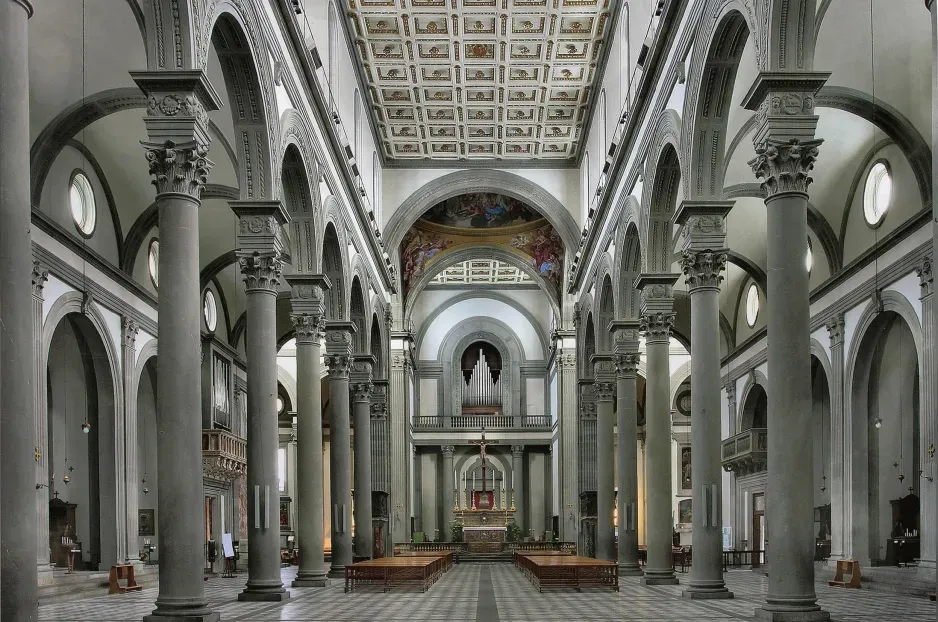
Architects: Filippo Brunelleschi, Antonio Manetti
Architectural style: Renaissance architecture
Chapel
The congregation has 38 side churches (two sanctuaries having been surrendered to entryways), which contain an essential measure of works of art. The most critical is the Bini-Capponi Church, lodging the St. Monica Laying out the Standard of the Augustinian Nuns painting by Francesco Botticini. The Corbinelli sanctuaries works are by Andrea Sansovino, Cosimo Rosselli and Donnino and Agnolo del Mazziere.
In the churches of the transept are altarpieces by Filippino Lippi. Likewise in the transept is an ensemble from which the Frescobaldi Marquisses could take part in the ceremonies without being seen by the group.
The sacristy, got to through an entryway in what might have been the left 6th church went before by a great vestibule by Simone del Pollaiolo, was planned by Giuliano da Sangallo in 1489, and has an octagonal arrangement. It is home to a reflection painting of St. Fiacre restoring the Wiped out (1597) by Alessandro Allori (1596) dispatched by Christine of Lorraine, Fantastic Duke Ferdinando I de’ Medici’s better half.
Michelangelo's Crucifix
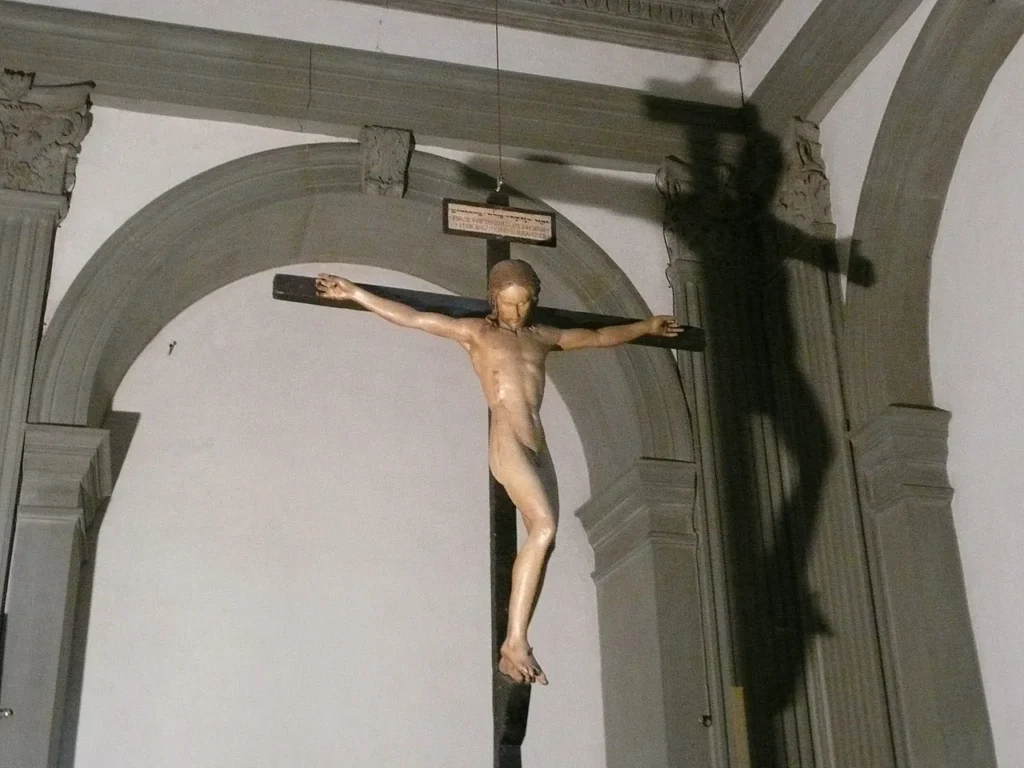
Michelangelo Buonarroti, when he was seventeen years of age, was permitted to make physical examinations on the cadavers coming from the community’s medical clinic; in return, he shaped a wooden cross which was set over the high raised area. Today the cross is in the octagonal sacristy that can be reached from the west walkway of the congregation.
Cloisters and the Cenacolo
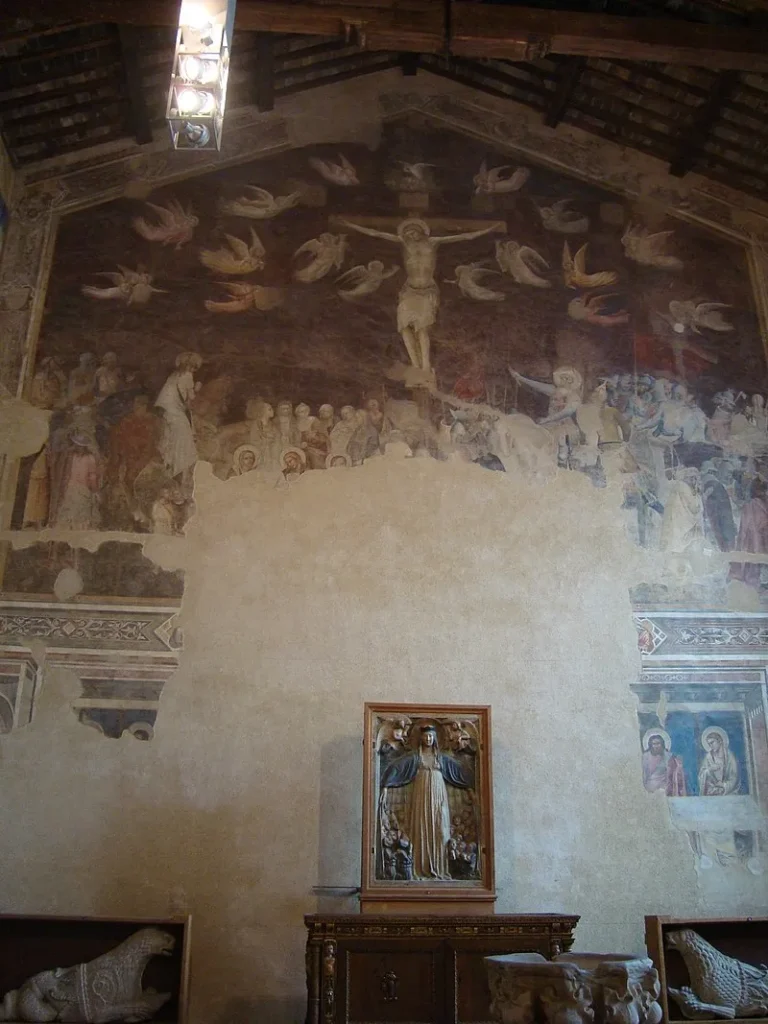
The religious circle had two orders, called Chiostro dei Morti and Chiostro Grande (“House of the Dead” and “Stupendous Group”). The main takes its name from the incredible number of gravestone improving its walls, and was worked around 1600 by Alfonso Parigi. The last option was built in 1564-1569 by Bartolomeo Ammannati in a classicistic style.
The previous cloister likewise contains the incredible refectory (Cenacolo di Santo Spirito) with an enormous fresco depicting the Execution over a fragmentary Last Dinner, both credited to Andrea Orcagna (1360-1365). It is one of the uncommon instances of Late Gothic Craftsmanship which can in any case be found in Florence. The room likewise brags an assortment models from the eleventh fifteenth hundreds of years, including two low reliefs by Donatello, a high help by Jacopo della Quercia (Madonna with Kid) and two marble figures by Tino da Camaino (1320-1322).
Feast Day
Feast Day : 28 August
The City of Florence was increasingly generous and in 1397 the annual allocation of a large fund was decided for the construction of a new and larger Basilica. The amount would be paid every 28 August for the feast of St. Augustine.
Church Mass Timing
Monday : 9.00 am
Tuesday : 9.00 am
Wednesday : 9.00 am
Thursday : 9.00 am
Friday : 9.00 am
Saturday : 9.00 am, 6.00 pm
Sundays and holidays : 9.00 am , 10.30 am , 6.00 pm
Church Opening Time:
Monday : 10:00 am – 1:00 pm, 3:00 pm – 6:00 pm
Tuesday : 10:00 am – 1:00 pm, 3:00 pm – 6:00 pm
Wednesday : Closed
Thursday : 10:00 am – 1:00 pm, 3:00 pm – 6:00 pm
Friday : 10:00 am – 1:00 pm, 3:00 pm – 6:00 pm
Saturday : 10:00 am – 1:00 pm, 3:00 pm – 6:00 pm
Sunday : 11:30 am – 1:30 pm, 3:00 pm – 6:00 pm
Contact Info
Address:
Piazza Santo Spirito, 30, 50125 Florence FI, Italy.
Phone : +39055210030
Accommodations
Connectivities
Airway
Florence Airport (FLR) to Basilica of the Holy Spirit Florence, Italy distance between 20 min (11.8 km) via Viadotto del Ponte all’Indiano.
Railway
Santa Maria Novella railway station to basilica of the holy spirit florence italy distance between 14 min (5.6 km) via SS67.

